The Metate’s Ancient Dance
A Photo Essay by Lisette Morales McCabe
Beneath the comal, the flames swayed with a gentle warmth, mirroring the graceful cooking style of my late maternal grandmother, Emilia Velazquez, as she artfully crafted her tortillas. The tortillas puffed up, releasing an aroma known only to those who truly appreciate and understand the art. To savor these exquisite tortillas, one had to fully grasp the labor-intensive process that started well before dawn.
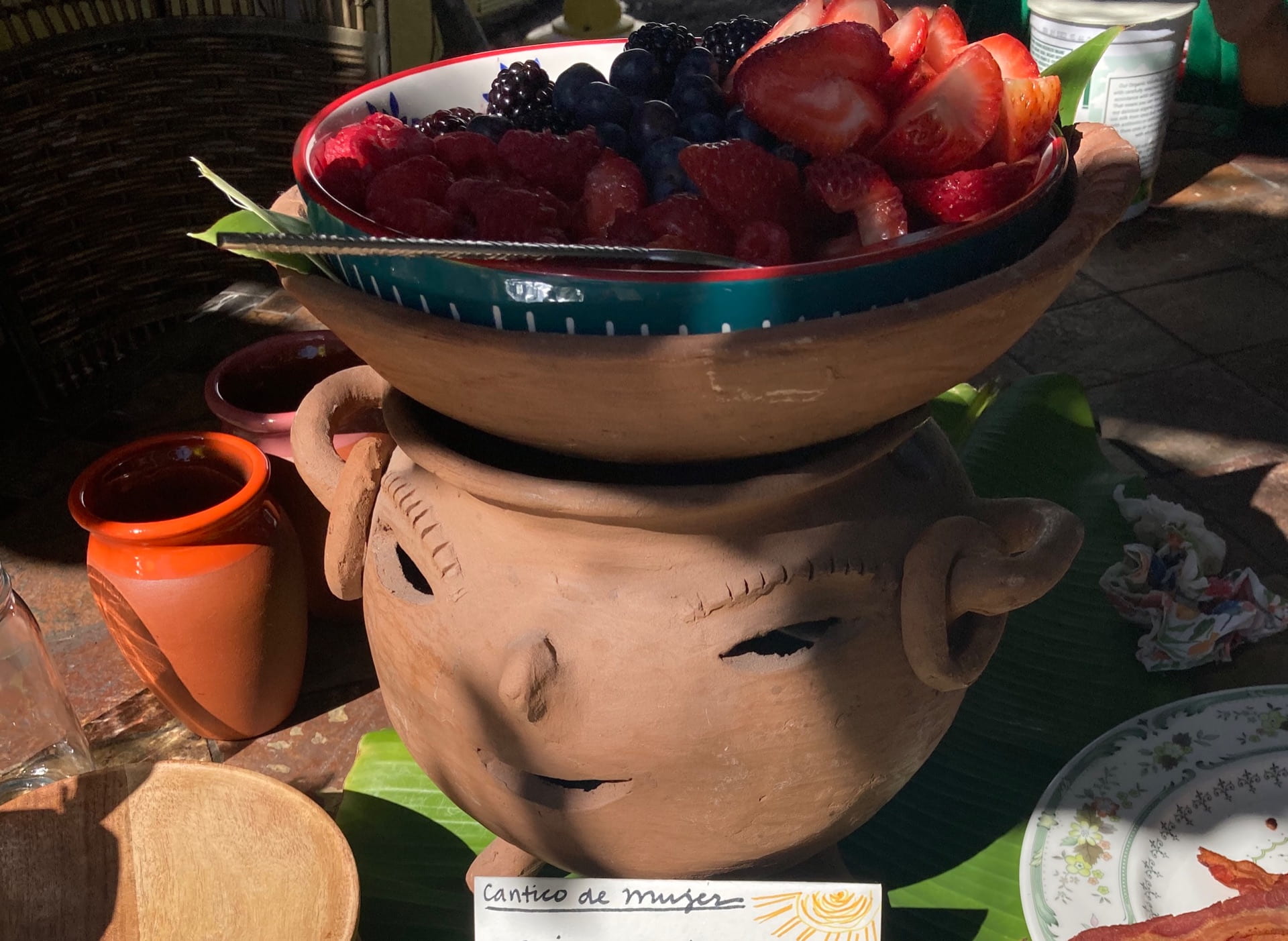
A “caballo bayo” it’s portable ceramic stove, a true masterpiece of Nicaraguan art, and a testament to its Indigenous legacy, is proudly displayed in Naples, Florida. Photo by Lisette Morales.
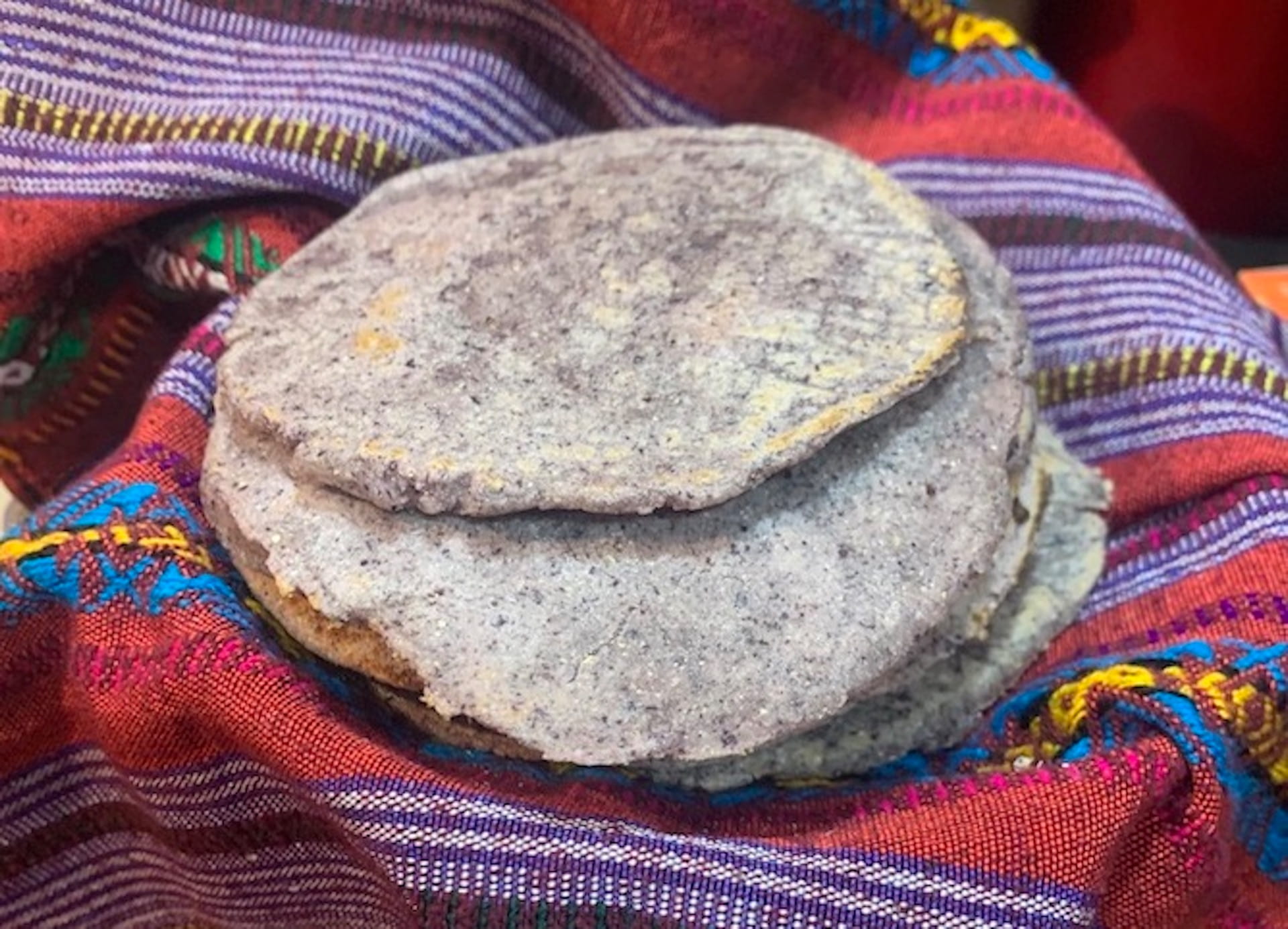
The rich aroma of freshly made blue corn tortillas fills the air, thanks to the skillful hands of Lucrezia Dipasquale in Naples, Florida. Photo by Lisette Morales.
Emilia woke up before the roosters, and she meticulously boiled and nixtamalize[1] the corn, then painstakingly ground it into a masa dough using a substantial stone slab known as a metate with a stone rolling pin called the mano(Nixtamalization (/nɪkstəməlɪˈzeɪʃən/) is a process for the preparation of maize, or other grain, in which the grain is soaked and cooked in an alkaline solution, usually limewater (but sometimes aqueous alkali metal carbonates), washed, and then hulled). The metate is a traditional Mesoamerican tool used to process grain and seeds into flour. Her hands moved the mano over the metate in a rhythmic, soothing horizontal motion, evoking an ancient dance, perhaps guided by Xilonem, with an “M”, the youthful female corn energy.
A metate and its mano, adorned with roses stands as a symbol of tradition at Lisette Morales’ home in Naples Florida. Photo by Lisette Morales.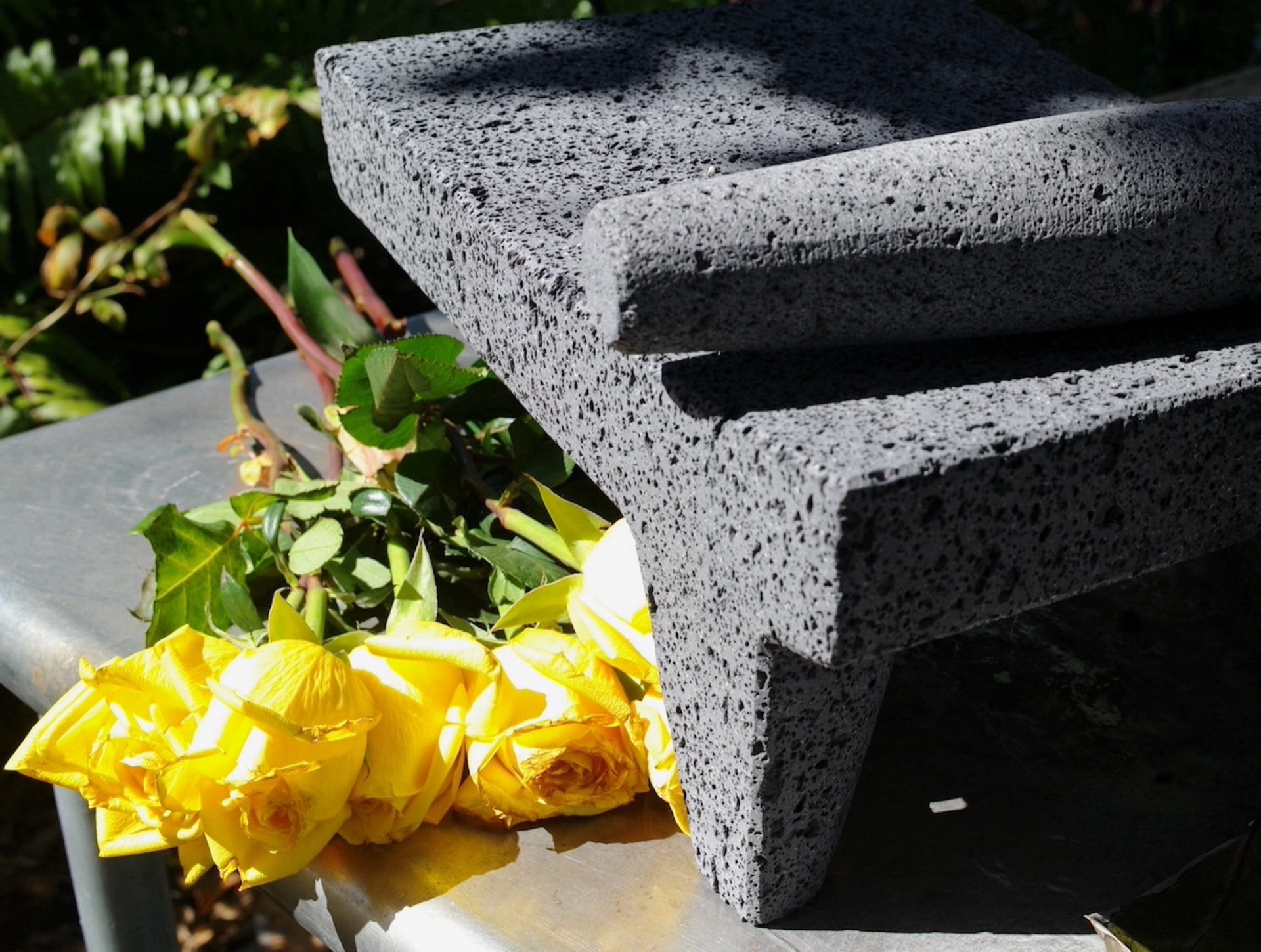
These childhood memories take me back to the early 1980s, a time when I would often find myself at Emilia’s modest ranch, called San Diego, in Chontales, Nicaragua. It was a place deeply steeped in family history. My late mother, Monserrat Morales, spent her formative years in that very house, where she absorbed the Indigenous recipes that would shape her culinary heritage. She fondly reminisced about how, decades later, Emilia’s kitchen remained virtually unchanged, like a timeless snapshot from the past.
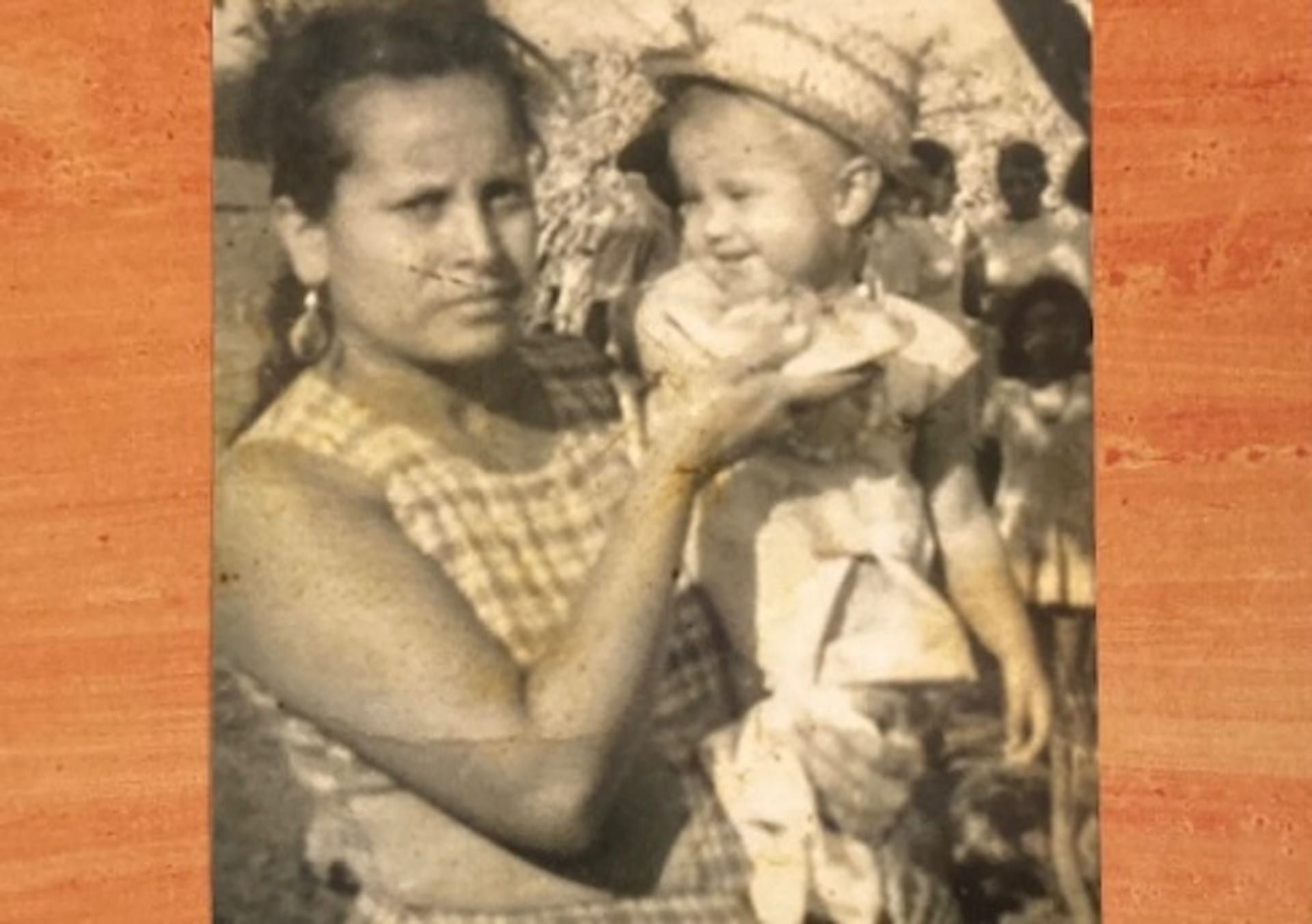
An archival photo takes us back to the 1970s, capturing Monserrat Morales and Lisette Morales in her childhood years in Chontales, Nicaragua. Photo from family archive. Illustration by Lisette Morales.
My mother often spoke of Emilia and of Mercedes Madriz, her grandmother, a woman I never had the privilege of meeting, yet she remained a central figure in my mother’s life. Within our family narrative, these remarkable women played pivotal roles, their stories intricately woven across generations. Sadly, all three have now departed from this world. Tragically, Mercedes met her untimely end in a devastating fire at that very ranch in 1952. Emilia, on the other hand, graced us with her presence for many years but eventually succumbed to a stroke in 1993, taking with her a treasury of culinary wisdom collected over the decades. Lastly, Monserrat, the bearer of numerous traditions, left us in August 2022 due to a severe infection. With their passing, I have inherited not only an immense sense of loss but also a profound responsibility to safeguard their legacies and the precious recipes that have now been entrusted to me and my four sisters.
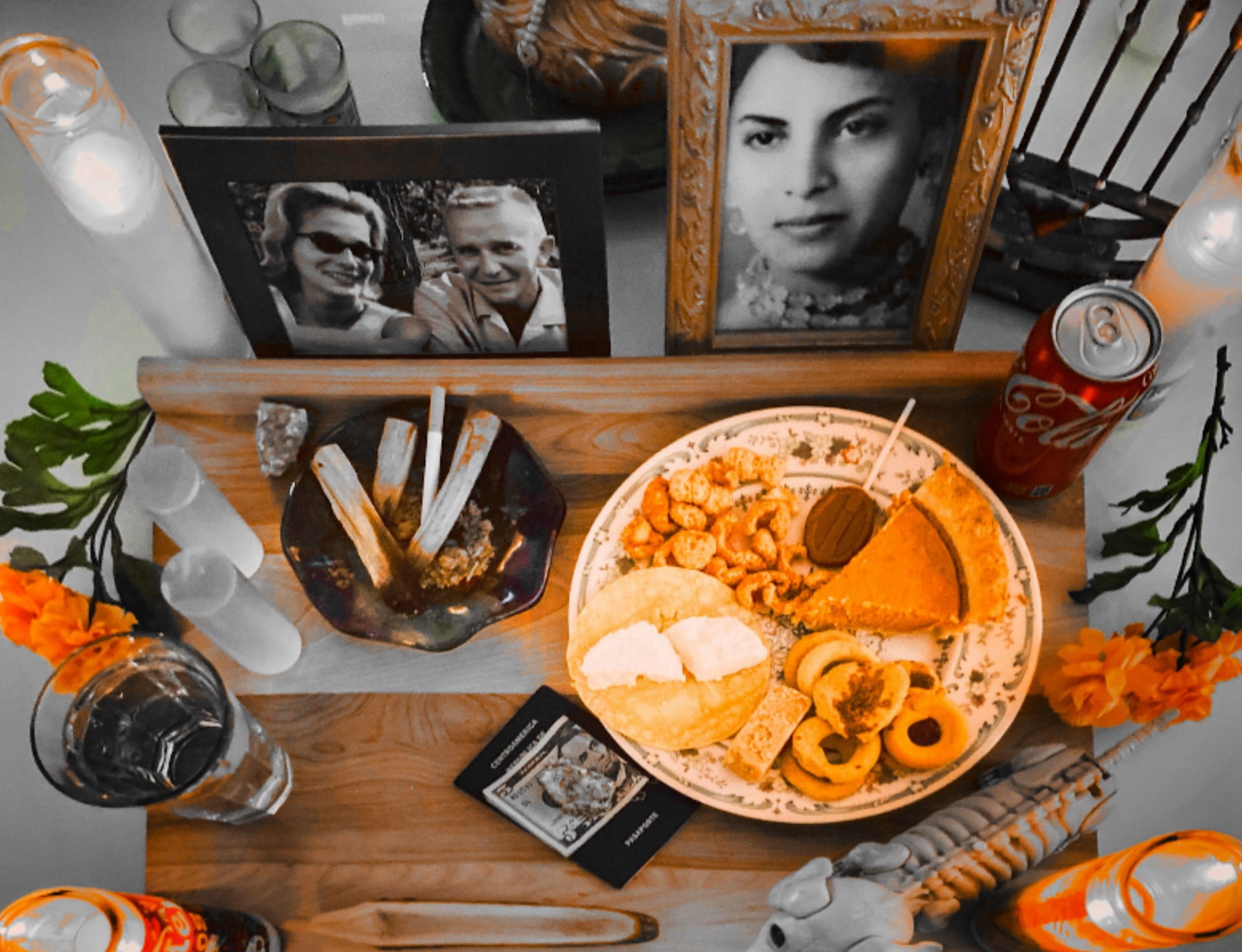
Lisette Morales and her husband, Sean McCabe, pay homage to their parents with offerings for the Day of the Dead. Photos in the altar from left to right: Ada and Harold McCabe and Monserrat Morales. Naples, Florida. Photo by Lisette Morales.
In early 2022, I purchased a humble metate from a local store in Immokalee, Florida. Despite its simplicity, this metate has played a crucial role in my journey, connecting me to a tool that has been employed for countless generations. My 23-year-old daughter Lucrezia Dipasquale asked me to teach her how to make tortillas during one of her college breaks. More recently, she spent time practicing with the metate, grinding rice to condition the stone.
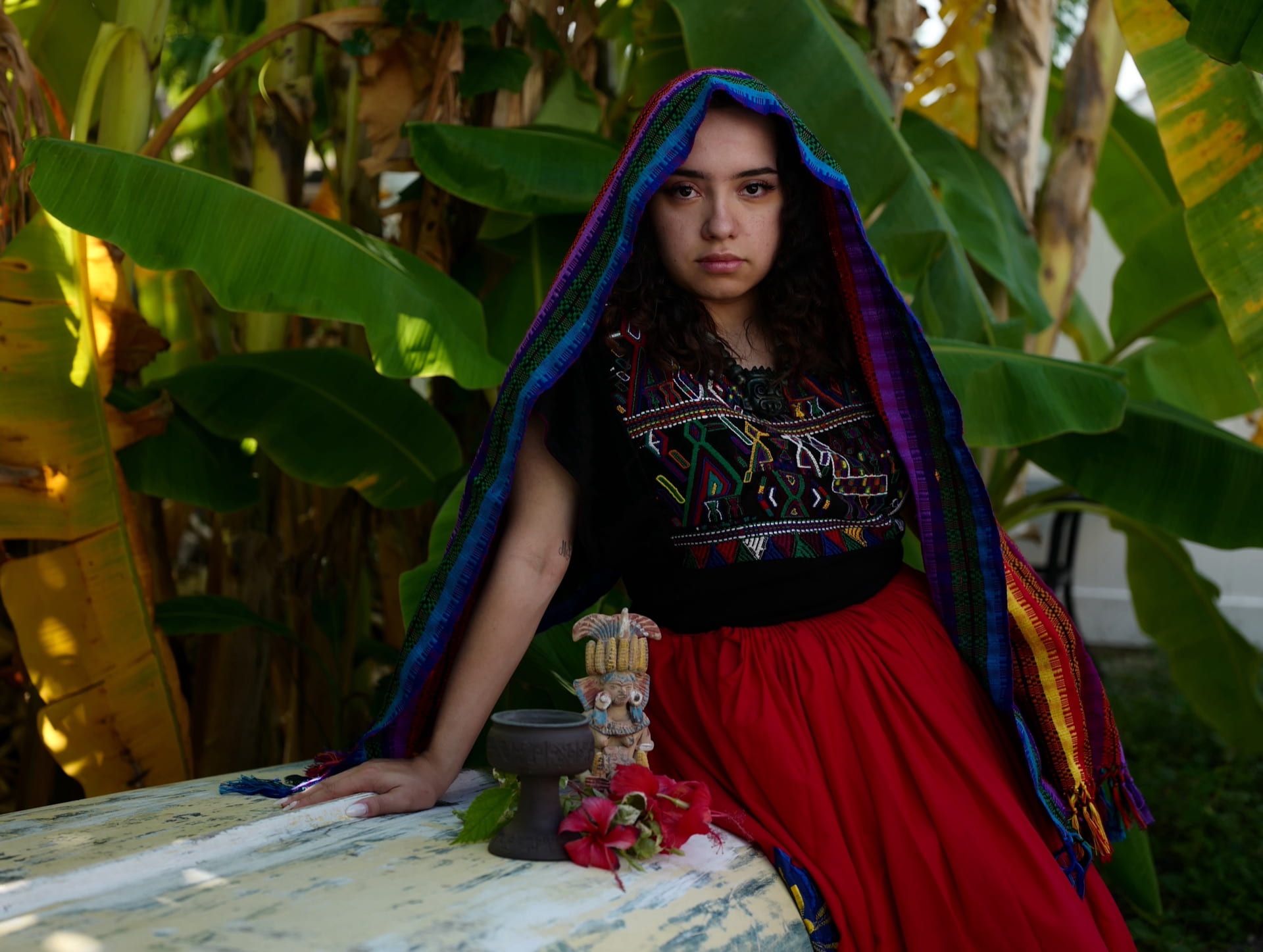
Lucrezia Dipasquale embodies the spirit of Xilonem, with an “M”, the female energy of young corn, as she poses in the backyard of her home in Naples, Florida. Photo by Lisette Morales.
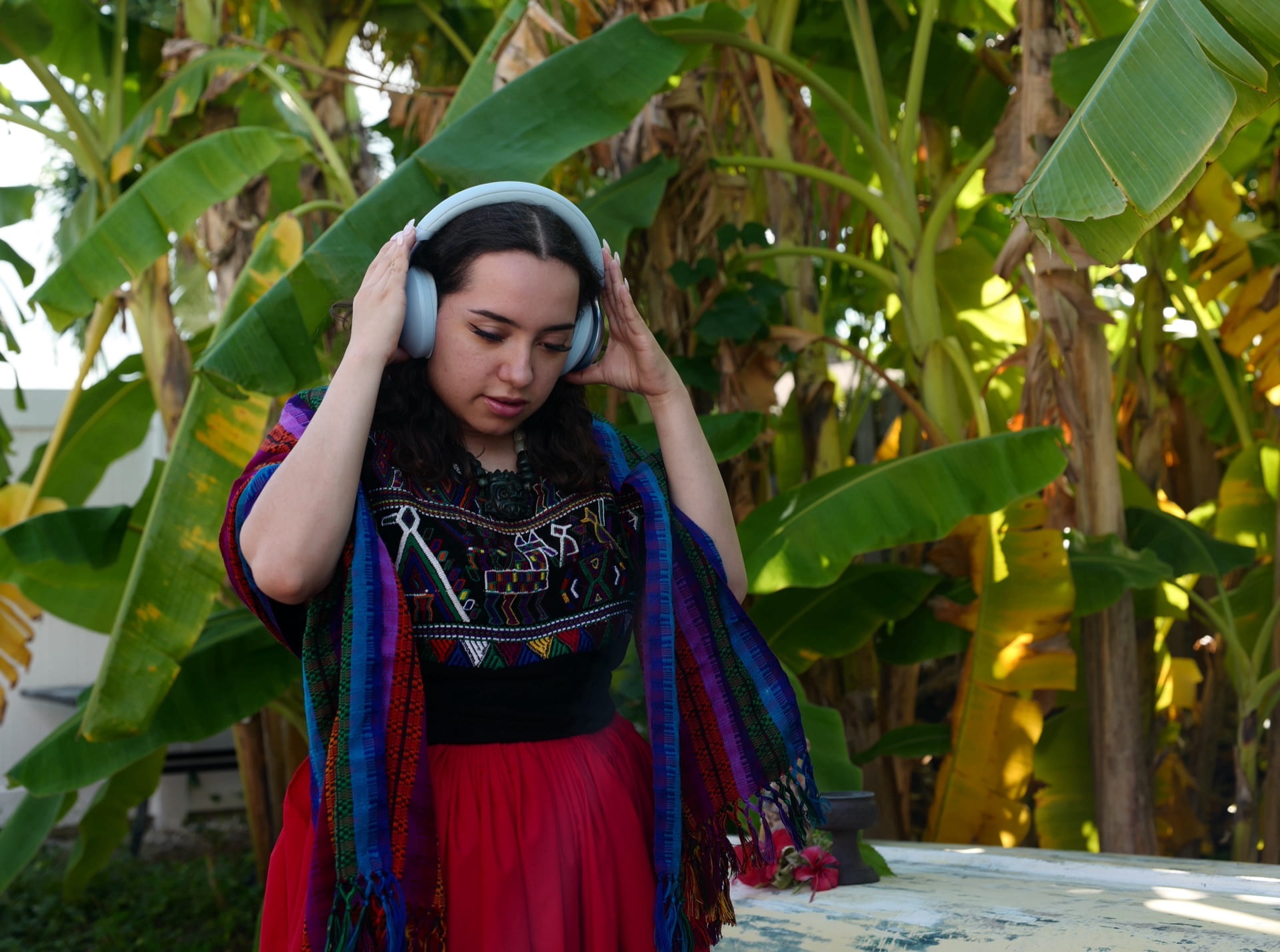
Lucrezia Dipasquale at her home in Naples, Florida. Photo by Lisette Morales.
Lucrezia has expressed how she finds the process meditative. She eagerly looks forward to discovering the stories and recipes connecting us to my family’s Nahua world in distant homelands. Our next culinary adventure will involve making pinolillo, a drink crafted from ground corn, cacao, cinnamon, allspice, and cloves. This beverage holds a special place in our hearts, serving as a delicious link to our ancestral past but also a profound means of coping, healing, and paying homage to our heritage.
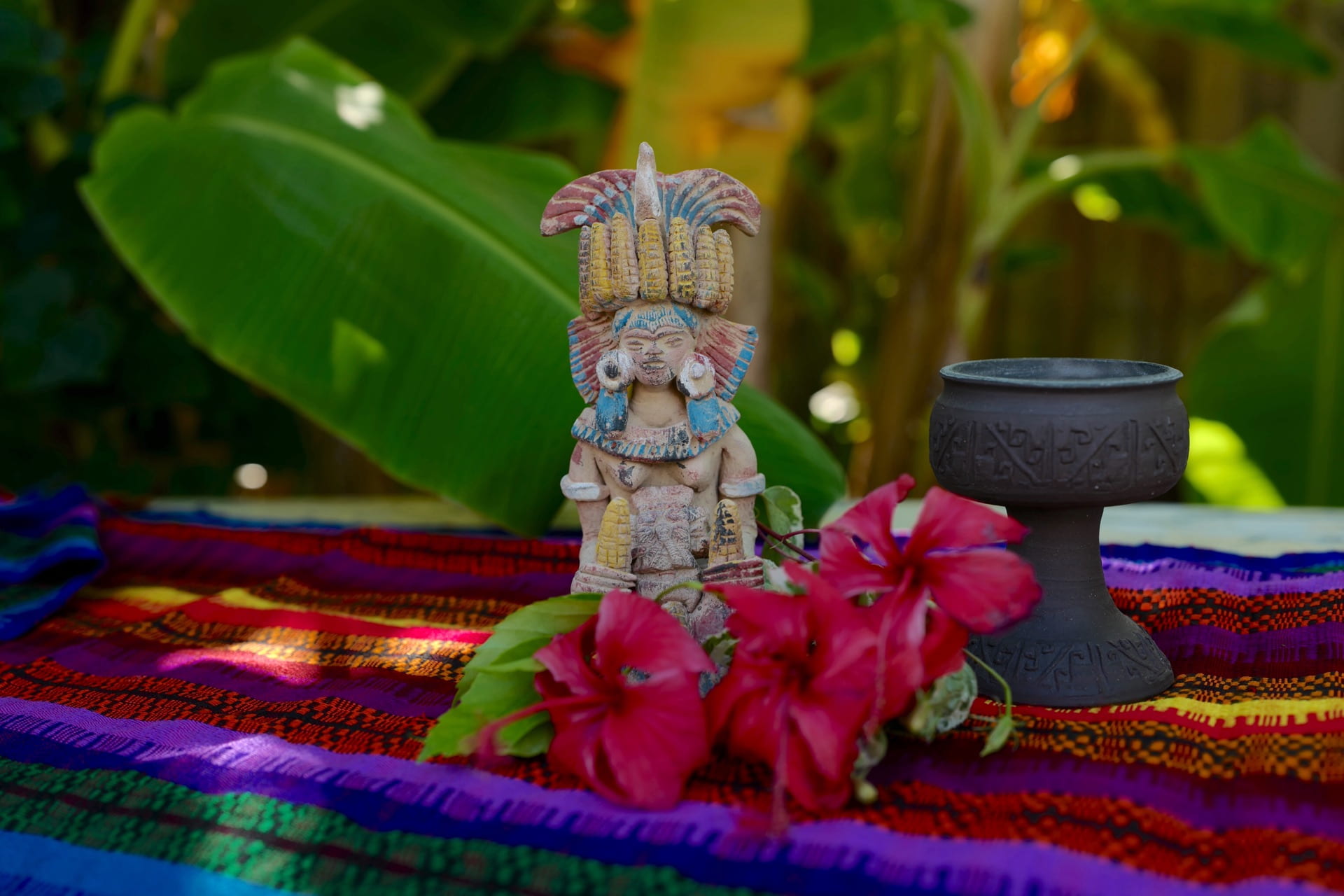
A silent guardian, Xilonem, with an “M,” watches over the family’s corn patch at Lisette Morales’ residence in Naples, Florida. Photo by Lisette Morales.
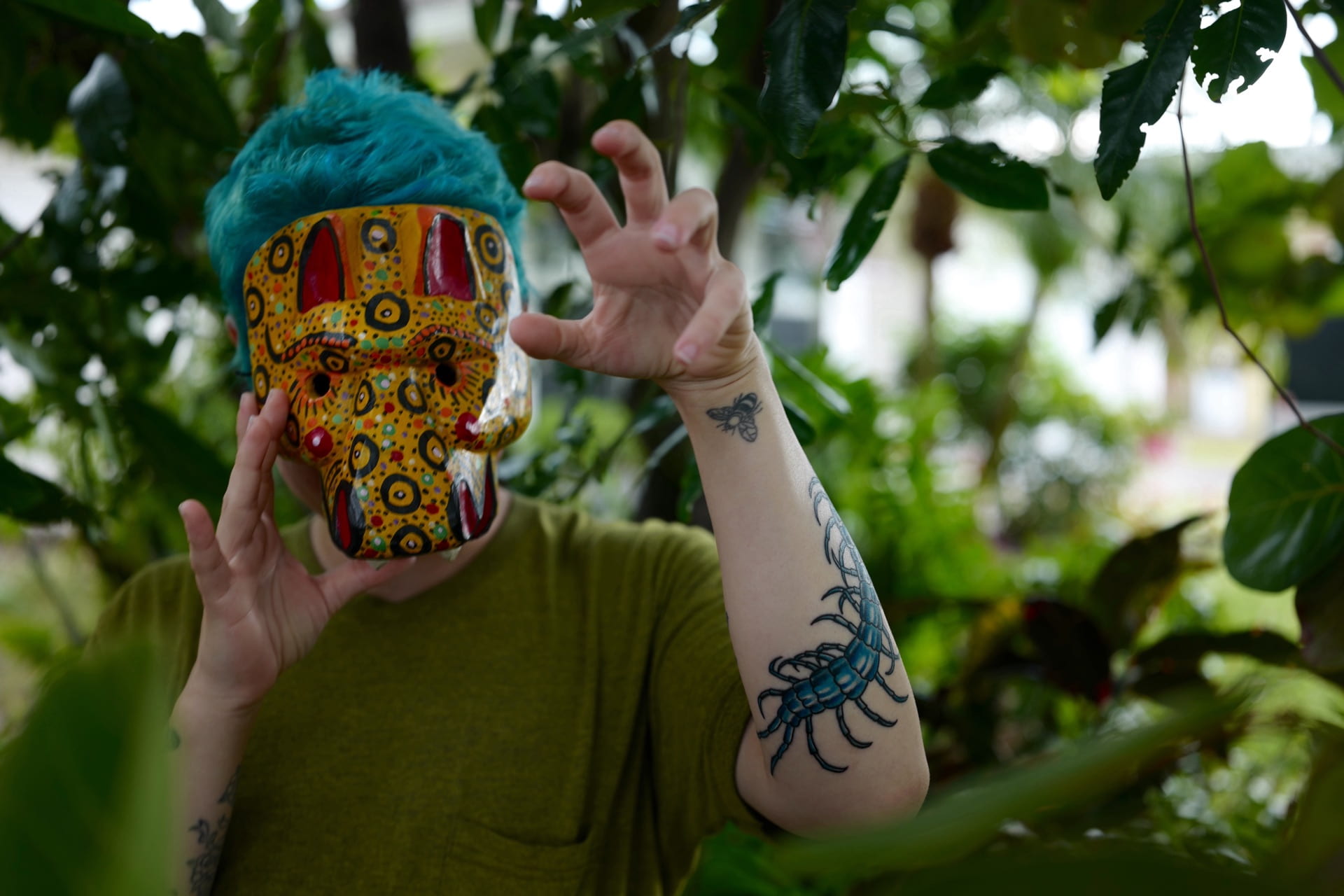
Mars Morales embodies the spirit of Tamagastad & Cipactonal, as they wear a jaguar mask from Masaya, Nicaragua, all while at their family’s residence in Naples, Florida. Photo by Lisette Morales.
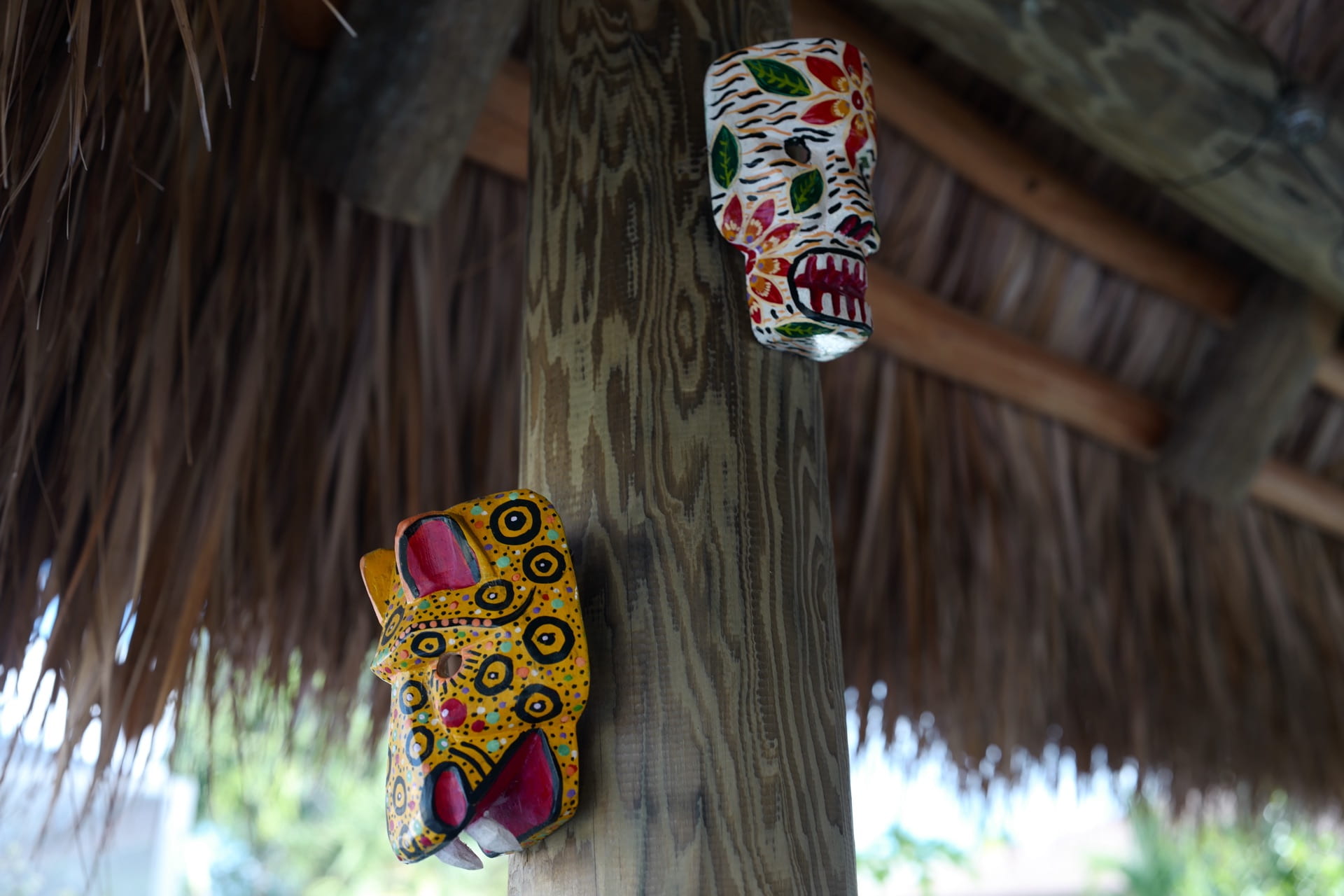
Masks from Masaya, Nicaragua, at the home of Lisette Morales and Sean McCabe in Naples, Florida. Photo by Lisette Morales.
[1] Nixtamalization (/nɪkstəməlɪˈzeɪʃən/) is a process for the preparation of maize, or other grain, in which the grain is soaked and cooked in an alkaline solution, usually limewater (but sometimes aqueous alkali metal carbonates), washed, and then hulled.
La Danza Antigua del Metate
Un ensayo fotográfico de Lisette Morales McCabe
Por Lisette Morales McCabe
Debajo del comal, las llamas se balanceaban con una suave calidez, reflejando la elegante manera de cocina de mi difunta abuela materna, Emilia Velázquez, mientras elaboraba artísticamente sus tortillas. Las tortillas se hincharon, liberando un aroma conocido sólo por quienes realmente aprecian y comprenden el arte. Para saborear estas exquisitas tortillas, había que comprender plenamente el laborioso proceso que comenzó mucho antes del amanecer

Un “caballo bayo” es una estufa portátil de cerámica, una verdadera obra maestra del arte nicaragüense y su legado indígena, se usa para servir alimentos en el hogar de Lisette Morales y Sean McCabe en Naples, Florida. Foto por Lisette Morales.

El rico aroma de tortillas de maíz pujagua recién hechas por las manos hábiles de Lucrezia Dipasquale, en su hogar de Naples, Florida. Foto por Lisette Morales.
Emilia se despertó antes que los gallos, hirvió y nixtamalizó meticulosamente el maíz, luego lo molió minuciosamente hasta obtener una masa usando una losa de piedra sustancial conocida como metate con un rodillo de piedra llamado mano (nixtamalización es un proceso tradicional de preparación del maíz en el que los granos secos se cuecen y se sumergen en una solución alcalina, generalmente de agua y cal alimentaria). El metate es una herramienta tradicional mesoamericana que se utiliza para procesar granos y semillas para convertirlos en harina. Sus manos movían la mano sobre el metate en un movimiento horizontal rítmico y relajante, evocando una danza antigua, quizás guiada por Xilonem, con una “M”, la energía femenina juvenil del maíz.

Un metate y mano adornados con rosas amarillas como símbolo de tradición en el hogar de Lisette Morales. Foto por Lisette Morales.
Estos recuerdos de la infancia me transportan a principios de la década de 1980, una época en la que a menudo me encontraba en el modesto rancho de Emilia, llamado San Diego, en Chontales, Nicaragua. Era un lugar profundamente impregnado de historia familiar. Mi difunta madre, Monserrat Morales, pasó sus años de formación en esa misma casa, donde absorbió las recetas indígenas que darían forma a su herencia culinaria. Recordó con cariño cómo, décadas después, la cocina de Emilia permaneció prácticamente sin cambios, como una instantánea atemporal del pasado.

Una foto de archivo nos transporta a la década de 1970, mostrando a Monserrat Morales y Lisette Morales en su niñez en Chontales, Nicaragua. Foto de archivo familiar. Ilustración por Lisette Morales.
Mi madre hablaba a menudo de Emilia y de Mercedes Madriz, su abuela, una mujer a la que nunca tuve el privilegio de conocer, pero que siguió siendo una figura central en la vida de mi madre. Dentro de nuestra narrativa familiar, estas extraordinarias mujeres desempeñaron papeles fundamentales y sus historias están intrincadamente entrelazadas a lo largo de generaciones. Lamentablemente, las tres ya han partido de este mundo. Trágicamente, Mercedes encontró su prematuro final en un devastador incendio en ese mismo rancho en 1952. Emilia, por otro lado, nos honró con su presencia durante muchos años, pero finalmente sucumbió a un derrame cerebral en 1993, llevándose consigo un tesoro de sabiduría culinaria. recopilados a lo largo de las décadas. Por último, Monserrat, portadora de numerosas tradiciones, nos dejó en agosto de 2022 debido a una grave infección. Con su fallecimiento, he heredado no sólo un inmenso sentimiento de pérdida sino también una profunda responsabilidad de salvaguardar sus legados y las preciosas recetas que ahora nos han sido confiadas a mí y a mis cuatro hermanas.

Lisette Morales y su esposo Sean McCabe rinden homenaje a sus padres con un altar para el día de los muertos. Fotos en el altar de izquierda a derecha: Ada y Harold McCabe and Monserrat Morales. Naples, Florida. Foto por Lisette Morales.
A principios de 2022, compré un humilde metate en una tienda local en Immokalee, Florida. A pesar de su simplicidad, este metate ha jugado un papel crucial en mi viaje, conectándome con una herramienta que se ha utilizado durante innumerables generaciones. Mi hija Lucrezia Dipasquale, de 22 años, me pidió que le enseñara a hacer tortillas durante una de sus vacaciones universitarias. Más recientemente, pasó un tiempo practicando con el metate, moliendo arroz para acondicionar la piedra.

Lucrezia Dipasquale personifica el espíritu de Xilonem, con una “M”, la energía femenina juvenil del maíz, posa en su residencia de Naples, Florida. Foto por Lisette Morales.

Lucrezia Dipasquale en el patio de su hogar en Naples, Florida. Foto por Lisette Morales.
Lucrezia ha expresado que encuentra el proceso meditativo. Ella espera ansiosamente descubrir las historias y recetas que nos conectan con el mundo nahua de mi familia en países lejanos. Nuestra próxima aventura culinaria consistirá en preparar pinolillo, una bebida elaborada con maíz molido, cacao, canela, pimienta de Jamaica y clavo. Esta bebida ocupa un lugar especial en nuestros corazones y sirve como un vínculo delicioso con nuestro pasado ancestral, pero también como un medio profundo para afrontar situaciones, sanar y rendir homenaje a nuestra herencia.

Como una guardiana silenciosa, Xilonem, con una “M”, vela por la parcela de maíz de la familia Morales McCabe en Naples, Florida. Foto por Lisette Morales.

Mars Morales personifica al espíritu de Tezcatlipoca, con una máscara de jaguar hecha en Masaya, Nicaragua, posa en el hogar de su familia en Naples, Florida. Foto por Lisette Morales.

Máscaras de Masaya, Nicaragua, en el patio de Lisette Morales y Sean McCabe en Naples, Florida. Foto por Lisette Morales.
Lisette Morales McCabe is a Nicaraguan-born photographer. Her children Mars Morales, 26, and Lucrezia Dipasquale, 23, both support and participate in Lisette’s projects. Lisette resides, with her husband Sean, in Naples, Florida. To learn more about her work please her website www.lisettemorales.com
Lisette Morales McCabe es una fotógrafa nacida en Nicaragua. Sus hijos Mars Morales, 26, y Lucrezia Dipasquale, 23, la apoyan y participan en sus proyectos. Lisette reside, con su esposo Sean, en Naples, Florida. Para conocer más sobre su trabajo por favor visite su sitio www.lisettemorales.com
Related Articles
Extractivism and Colonialism in Argentina: A View from the Patagonia
It was snowing the day in early August when I arrived at Lof Pillan Mahuiza, a Mapuche-Tehuelche community around 60 miles from Esquel, the provincial capital of Chubut, Argentina.
A Chair in the Room: The Semiotics of Sitting
In Latin America, the chair occupies a central and often overlooked place in everyday life. It is present in rural homes and public plazas, inside crowded city schools and at the edges of municipal offices.
Afro-Latinidades and World Diasporas: Community-Building through Public Programs and Curricular Development
Blackness has reshaped the fabric of the Americas. From the Middle Passage to contemporary diasporas, Blackness has constituted a transhemispheric demographic, cultural and historical reality.




